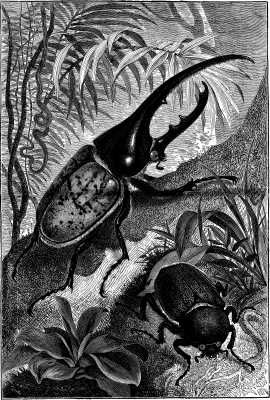Scientific American, Volume XLIII., No. 25, December 18, 1880, by Various, is part of the HackerNoon Books Series. You can jump to any chapter in this book here. THE HERCULES BEETLE.
THE HERCULES BEETLE.
In the handsome engraving herewith are shown the male and female of the Hercules beetle (Dynastes hercules) of Brazil. The family of the Dynastidæ comprises some of the largest and most beautiful of the beetle race, and all of them are remarkable for enormous developments of the thorax and head. They are all large bodied and stout limbed, and by their great strength abundantly justify their generic name, Dynastes, which is from the Greek and signifies powerful. The larvæ of these beetles inhabit and feed upon decaying trees and other rotting vegetable matter, and correspond in size with the mature insects. Most of them inhabit tropical regions, where they perform a valuable service in hastening the destruction of dead or fallen timber.
An admirable example of this family of beetles is the one here represented. In the male of the Hercules beetle the upper part of the thorax is prolonged into a single, downward curving horn fully three inches long, the entire length of the insect being about six inches. The head is prolonged into a similar horn, which curves upward, giving the head and thorax the appearance of two enormous jaws, resembling the claw of a lobster. The real jaws of the insect are underneath the lower horn, which projects from the forepart of the head. The under surface of the thorax-horn carries a ridge of stiff, short, golden-yellow hairs, and the under surface and edges of the abdomen are similarly ornamented.
The head, thorax, and legs are shining black; the elytra, or wing-covers, are olive-green, dotted with black spots, and are much wrinkled. The wings are large and powerful.

The female Hercules is quite unlike the male. It is much smaller, being not more than three and a half inches long, is without horns, and is covered with a brown hairy felt.
These beetles are nocturnal in habit, and are rarely seen in the daytime, except in dark hiding places in the recesses of Brazilian forests.
About HackerNoon Book Series: We bring you the most important technical, scientific, and insightful public domain books.
This book is part of the public domain. Various (2007). Scientific American, Volume XLIII., No. 25, December 18, 1880. Urbana, Illinois: Project Gutenberg. Retrieved https://www.gutenberg.org/cache/epub/21081/pg21081-images.html
This eBook is for the use of anyone anywhere at no cost and with almost no restrictions whatsoever. You may copy it, give it away or re-use it under the terms of the Project Gutenberg License included with this eBook or online at www.gutenberg.org, located at https://www.gutenberg.org/policy/license.html.

